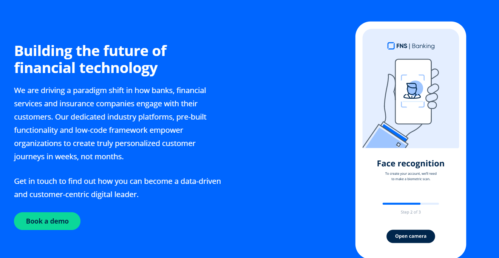09 September 2021
Can you replace custom software with low-code software development? The present and future of low-code

Low-code software development is one of those buzzwords that constantly return every now and then and every time it seems louder. It carries the promise of creating powerful professional applications with little to no coding. It raises interesting questions concerning the potential democratization of software development abilities. But is it really true? Can we develop apps without developers? TSH asked a group of experts these very questions.
According to Gartner, by 2024 so-called low-code software development might be responsible for as many as 65% of all app development activity.
Sounds pretty serious, doesn’t it? I’m going to take a closer look at the present and future of low code development platforms. But first, let’s start with the basics.
What is low-code software development?
Low-code software development refers to platforms that provide a development environment that makes it possible to create new applications using a graphical user interface, with little to no actual coding.
It seems that the concept of low-code development appeared in the early 90s and the emergence of WYSIWYG (What You See Is What You Get) editors such as the Dreamweaver (the contemporary version is more code-oriented). A closely related term is no-code development, which can often be used to describe the very same platforms and services.
Some of the popular low-code/no-code development platforms include:
- Zoho Creator – a popular low-code platform, which can be used to create apps of various kinds and for all kinds of industries and thus automate workflows in your business.
- Shopify – an e-commerce platform that also makes it easy to create a shopping site without coding, with the use of ready-made templates, pre-made content, widgets and WYSIWYG editors.
- Divi – a WordPress-oriented visual page builder, which you can use to create complex websites by moving visual blocks.
- Zapier – a different kind of platform. This one makes it easier for two different apps to communicate, functioning as a translator of sorts between their APIs. With Zapier, you can extend the functionality of your app by integrating the functions and capabilities of other apps into it. As a result, it also works as a low-code or no-code platform.
Let’s learn even more about low-code platforms by introducing the guests of the recent CTO Roundtable. You’re welcome to watch it below. It talks more in-depth about many of the points I’m going to cover in this article.
Introducing the experts and… different approaches to low-code
During the CTO Roundtable debate about low-code platforms, TSH’s Gerbert Oude Velthuis talked to CTOs of three companies that represented different approaches to the concept.
- Remco Jorna of FintechOS
FintechOS is a low-code platform aimed at large banks and insurance companies to make it easier and (much) quicker for them to build new services and functionalities on top of or around existing infrastructure.

- Jasper Laagland of Factris
Factris buys unpaid invoices from companies and provides all kinds of supporting tools that help companies manage their invoices and assess financial risks. Factris originally used low-code platforms, but eventually made a decision to move to a wholly custom-made proprietary application.

- Bastiaan de Ruiter of Blanco
Blanco provides an investment platform for wealth managers. The company has proprietary software but is fond of using APIs to connect to all kinds of third-party services and plugins to extend functionality without much coding.
It seems that we have three completely different attitudes to low-code! That will make it easier to talk about the pros and cons of this approach.

Pros of low-code software development
Using low-code software development platforms has a couple of quite obvious benefits.
Good time-to-market
Low-code platforms provide lots of ready-made solutions for various application development challenges. Some of them are very common, such as login/registration or security, while some of them may be more industry-specific, such as fintech solutions offered by FintechOS. This allows you to develop applications and start business activity quickly.
MVP (Minimum Viable Product)
Consequently, a low-code platform may be a way to go for building a Minimum Viable Product. After all, it should not take much time to be ready to test.
Low cost
The barrier-to-entry for using low-code platforms is relatively low compared to custom software development both in terms of skills and money, especially when it comes to B2C oriented platforms. For example, Shopify plans start at $29.
Decent scalability/security
Low-code platforms typically provide all the important measures in terms of security (SSL, payment operations etc.) and scalability. When compared to poor custom software development, it may be preferable.
You can focus on your business
Companies that use low-code platforms typically do not need to hire skilled Node developers or DevOps engineers to maintain and operate the infrastructure, taking away a lot of complexity out of your tech. As FintechOS’s Remco Jorna says, “we hire hardcore developers to build our platforms so that our customers do not need them anymore.”
According to TSH’s CTO Marek Gajda: “Low code is the best if you want to experiment with something and don’t want to put too much money in it. If proof of concept works, it will probably require a more custom approach down the road”
Cons of low-code software development?
Of course, if it was all roses like that, everyone and their dog would be using low-code platforms by now. But it isn’t the case. Why? Low-code platforms do have some limitations:
Limited freedom
Bastiaan de Ruiter points out that “custom software development means using extension frameworks and a lot of libraries”. Just like in low-code platforms, you do use ready-made blocks that speed up development. Except, that in this instance you can achieve pretty much anything you want. In low-code platforms, you are typically limited to what you are given by the provider and what you can integrate.
Limited expertise
You can’t always give your clients everything they need. Especially in B2B relations, your clients may ask for various guarantees regarding your technological capability and the security of your application. When you use a low-code solution, you may lack the means or knowledge to provide it.
Limited scalability
It may work great at first, but when you decide that it is no longer sufficient for you, the cost of switching to a custom solution may be quite high.
You may still need professional developers
At a previous job, we used some sort of low-code environment. It was much easier to change something, so you need fewer developers. But for the implementation, we needed 40 people,” says de Ruiter. Low-code platforms may give your non-coding employees a lot of freedom, but you might still need a lot of help from devs every now and then.
And you may struggle to get them into your development teams
And you might sometimes find it difficult to find them as the best programming talents tend to be more interested in custom software development rather than implementing ready-made solutions.
Other than using a low-code development platform to make an app, you might be also interested in developing one yourself. Unlike the former, the latter is actually a really hard job that requires some hardcore coding.
We had the opportunity to work on the development of a high-level fintech framework for quick development of new finch apps. While this is not a pure low-code/no-code platform, since it does require clients to code the business logic, it does have many qualities of those platforms. It allows for adding many common features such as authorization, database, security, administration panel from a GUI.
A low-code platform may be a good business idea, but you should be prepared for a long and costly process. Reading the case study linked above is a good way to get an idea just how much!
Who is low-code for?
In light of these limitations, is it a good idea to use these platforms? It may be as long as you really are in the target market of these platforms:
- You can use them as an extension of existing custom software development projects. You can connect to your app via APIs. FintechOS is a good example of that. However, you still need some custom development for that.
- You can definitely use it to make an MVP. Making a good MVP may be beneficial for the growth of your custom project in the future. You might get a lot of good feedback and ideas on how to make it better and more unique.
- When you know exactly what you need and will need in the future and have a low-code platform that has just that. Perhaps your business does not require that much custom coding and ready-made solutions such as those offered by Shopify or Divi are sufficient for your needs?
- When you have a perfect match with your low-code provider. FintechOS’s Remco Jorna says: “It depends on the problem domain that you’re working in and that’s why we made a decision only to work for financial services, for banks and insurance companies”. A low-code platform that focuses on fintech only is bound to have solutions tailored for fintech and can give you much more than general purpose low-code platforms. The same goes for any other industry-specific low-code platform. However, even if you do have such a match, it still doesn’t mean that a low-code approach is always better. You should consult your projects with experts to make sure that you won’t find yourself quickly in need of something more flexible.
What about the future potential of low-code?
Is low-code the future?
Jasper Laagland predicts that creating software will certainly involve “putting blocks together’ and less custom code.”
Custom software development also goes in this direction with more and more stuff being abstracted away in the form of frontend frameworks such as React, Vue, or backend frameworks such as Node or Symfony. Storybook.io is also a good example of that trend. It lets you build components in isolation from the environment and reuse them freely, with consistent design and behavior. Solutions such as these might make development much faster, but you will still need to know coding to tie it together, respond to problems, ensure scalability and security and generally keep tabs on everything. You don’t want to be clueless about how your own software works.
All of the guests of the CTO Roundtable agree that while low-code platforms will continue to grow, the rise of “citizen developers” that create apps without programming knowledge will be confined to specific areas and that large successful businesses will be predominantly based on custom solutions with a touch of low-code. Of course, within these custom solutions they will continue to find new ways to abstract away, reuse and simplify all sorts of processes.
As you continue to do all that, the complexity of the custom software and business logic itself also grows. You will need devs to do the latter and make sense of the former. Your competitive edge will depend on it.
To sum it up – keep low-code software development in mind, but proceed with caution
Low-code software development definitely has its place, but it has limitations you need to work around in terms of:
- customization,
- your in-house expertise,
- long-term scalability,
- developer acquisition and retention.
Is it for you or perhaps you need custom software development instead?
Even if you read this article, you probably need to know more.
Reach out to us and describe the project to get more information.

